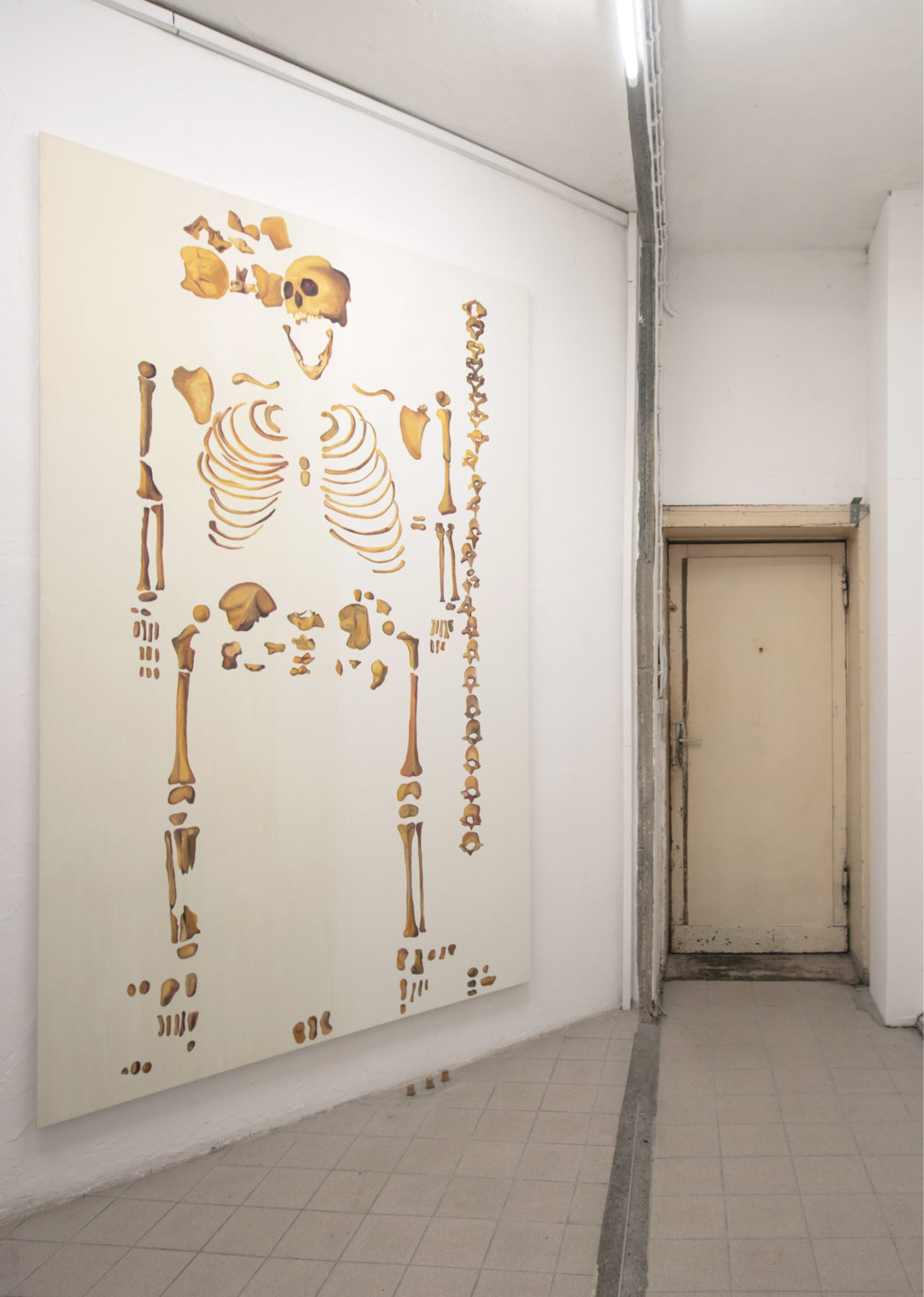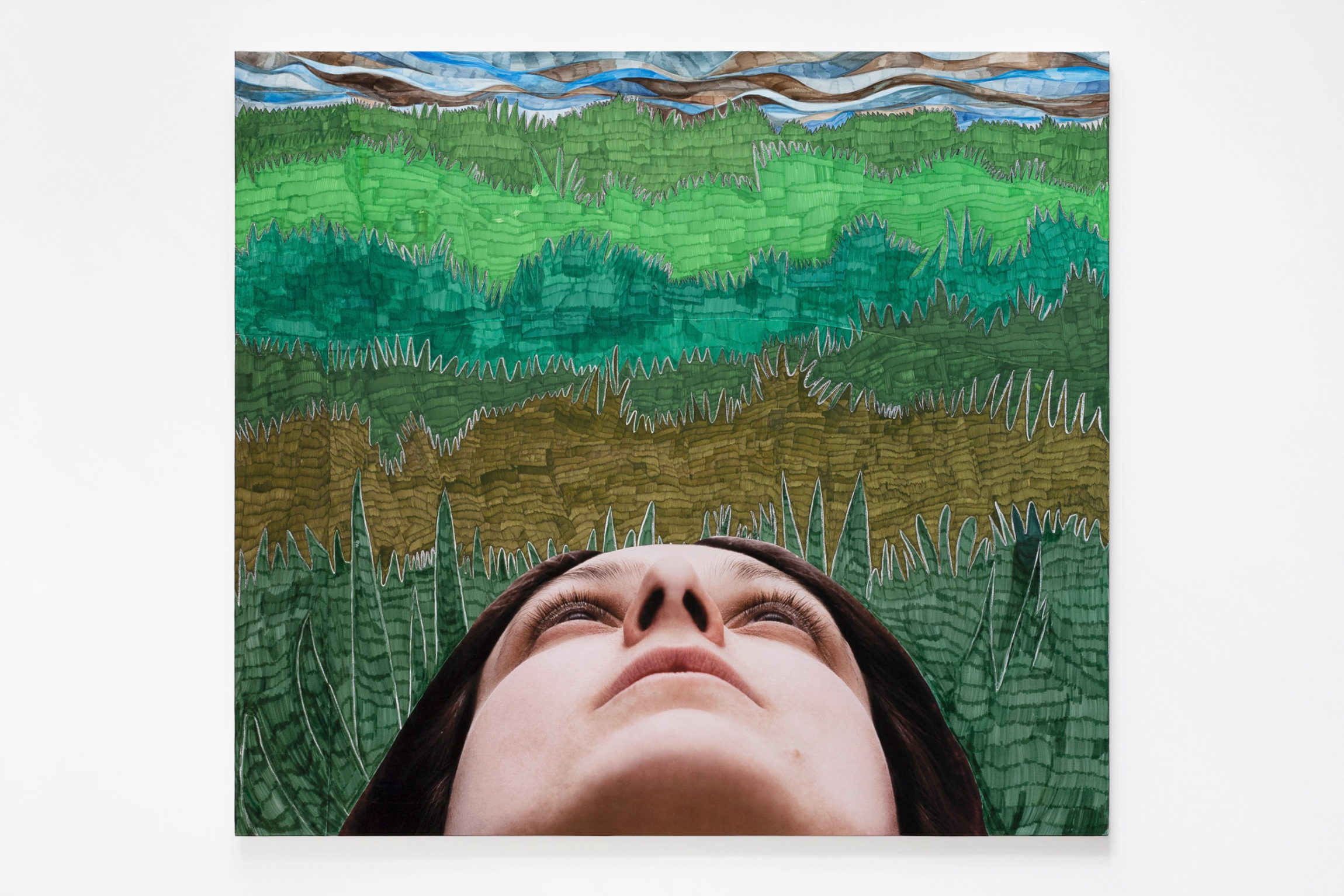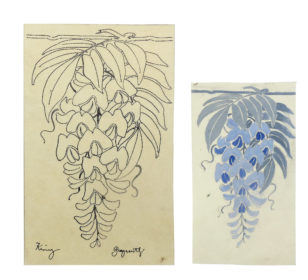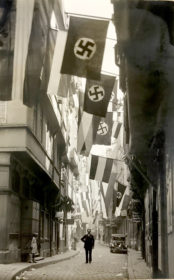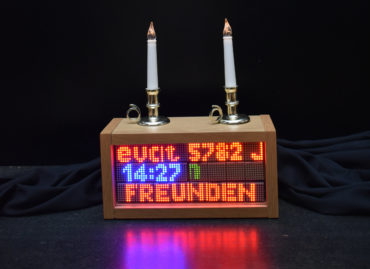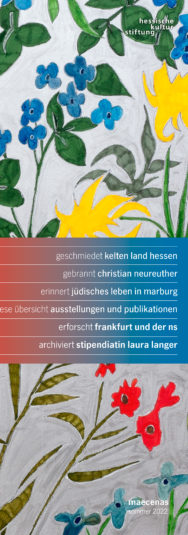scholarship-holder laura langer
Laura Langer is an artist born in 1986 in Buenos Aires, Argentina. Langer currently lives in London and is supported by a scholarship from the Hessische Kulturstiftung. Langer’s works speak of feelings and structures of the psyche, fears, desires and identity through symbolic images and the way they operate in the exhibition space. In London, Langer is conducting research on Aby Warburg’s Atlas Mnemosyne at the Warburg Institute. Working with photography and a growing archive of images, including her own photographs, the scholarship has allowed Langer to refine her approach to building a personal archive of images that is pivotal to her installation and painting practice. Upcoming and recent solo exhibitions include Lodos Gallery (Mexico City, 2023), Braunsfelder (Cologne, 2023), Kunsthaus Glarus (2022), Homesick (Weiss Falk, Basel, 2021, und The Wig, Berlin, 2021) and Liberty (Portikus, Frankfurt, 2020).
Laura Langer met curator Gianmaria Andreetta to discuss recent exhibitions and the role of photography in her work. He is a Swiss curator and writer based in Berlin.
This Interview is an extended Version of the german one, printed in the maecenas.
Gianmaria Andreetta I would like to begin by talking about houses and how we relate to them. In your recent exhibition at The Wig in Berlin in October 2021, titled Homesick , you built a large-scale labyrinth that ran through the space connecting two large, almost identical, paintings of a skeleton on either side. Homesick. Homesick is also the title of your previous solo exhibition at Weiss Falk in Basel (2021). I wanted to reflect on both the symbolism of the labyrinth as a house that traps and on working with repetition.
“Spatially, being face to face so close to a painting prevents the viewer from understanding their structural makeup. On a metaphorical level, a complete picture of a self is impossible when one is too close to the trials and tribulations of desire.” Luzie Meyer
I understand “tribulations of desire” as a push and pull towards what you want and the confusion that follows from this movement. The reason you find yourself in the tribulations of desire is the same reason you are getting too close to what you have always wanted. This confusion becomes energy as soon as it is experienced as a need.
Laura Langer Well, in the show I am not sure it manifests as getting closer, but there is clearly an incentive to loose or change perspective. When you enter the space, there is a kitchen and a bathtub. It is confusing at first, but that’s what the space at The Wig is like. How it originally was. In the first room, there is a painting of a human skeleton, a series of bones displayed next to each other. One can imagine they are on a table or floor. They are about to be examined, in a forensic way perhaps. The painting is fairly big, the human remains are probably double the size – if not bigger – than an actual human. The skeleton can be seen in its entirety as we take a few steps away.
The second room is entirely occupied by the labyrinth; the visitor enters it and has to walk through it. There is no other option. Well, the other option would be not to enter at all. The visitor loses their bearings against this architecture. The sheer size of the room and the time it takes to reach the other side generates distress and anxiety, but also the reassurance there is only one way out. Throughout the labyrinth, a strip of the second painting, the upper part, is visible across the room. The second painting is a copy of the first painting. It is only at the end of the labyrinth (in this case it doubles as a dead end) that the painting can be seen in its entirety. In this corner, there is no room to move much.
If it wasn’t for the first painting, the resilience of its image and feel, the second one would most likely appear as a deformed image. Bones up close look like fried chicken. Being too close creates distortion, or makes you see things in a different way. What Luzie means by tribulations of desire, I think, is the feeling of alienation and defamiliarization that is connected to the highly choreographed experience of the labyrinth. Anamorphoses too, which I have worked with before, are linked to a way of looking and moving.
Andreetta Anne Carson says that words come to us dead, just as starlight only reaches us when they have been extinguished for millions of years. I agree, I think words are veils and are more apt to hide than reveal. Words, like labyrinth, are embedded in a bizarre logical ground; they demonstrate a sort of telegraphic coding, meaning they are so marked by their mythical possession that there is no easy way for anything that’s buried beneath to come through. Is “labyrinth” a general term to describe being free of any frame of reference? Or on the contrary, is it a metaphor for destiny?
Langer It could be a metaphor for destiny, yes. Or a visual analogy of a big challenge or a hard time to go through, confusion. The labyrinth can be an image, too, when looked at as a floor plan. It can be a doodle, a drawing or a map. It could be a trap, a prison, and a holy place where you could find spiritual balance. Or the brain. There are all kinds of images that the word immediately evokes. Argentinian author Jorge Luis Borges once famously said: “It only takes two facing mirrors to build a labyrinth.” I have always liked this idea of a labyrinth appearing by magic. I imagine a mirror, someone bringing another mirror and putting it in front, and then boom! This continuation of corridors appears. I always thought this image is a good representation of relationships, in the sense that it also portrays people having a conversation or simple encounters. The mirror reflects the mirror that in turn reflects itself in an endless dialectical sequence, in the same way that people respond to each other when they get acquainted. In the exhibition space, the labyrinth presents a single image, the map or layout of a relationship at a given moment.
Andreetta But there is a contradiction: on the one hand, two mirrors facing each other constitute an immediate experience of the present, and on the other hand, there is a long history of labyrinths, and notably a mythological one.
Langer Yes, Luzie Meyer touched on the mythological aspects of labyrinths – when she wrote about my show at The Wig – I would say out of personal interest…Interpretations, of any kind, have to do with who is writing, their history and their own interest. That’s what happens with words, and the risk of being misunderstood in language too. In that sense, interpretation is a compromised activity – which I love – whereas I see architecture as a potentially simpler, but also more ideological experience of space, especially when it is abstracted or taken out of its ontological lineage, but also displaced from its original context, which for the labyrinth is mostly playgrounds and the gardens of royalty.
Andreetta What does a labyrinth mean then?
“A labyrinth doesn’t mean anything, and that’s its strength. I like that.” Susan Sontag
Langer A labyrinth doesn’t mean anything but does something. It requires you to have the patience not to lose your mind. It requires a certain level of awareness, being alert. Regardless of what you do and how long it takes, you will find the exit or die trying. The illusion of possibilities is what life feels like in general. There are so many options for everything, but only you know what to do and where to go. The labyrinth is a good metaphor for destiny and perhaps other things. As for its architecture… If you think about it, it is just a series of corridors. It is impractical and nonsensical by design.
Andreetta The impractical is often associated with the bourgeoisie; think of high fashion for example. Could the labyrinth be a metaphor for a change in class, the same way purgatory is an allegory for a penitent life? The French writer Didier Eribon describes changing class as being stuck in between worlds made of images of what others have achieved before us, which the class transfuge has no choice but to understand at a glance. It is the speed and order in which changes happen that is important and crucial. Adaptation and access are a matter of timing.
Langer It is. When you are feeling lost and going through a period of changes, a good thing to do is pause and change tempo. Transitions are a call for patience.
Andreetta When I said, via Anne Carson, that words reach us already dead, that’s what I meant. Words come with so much use and history that I question what they can still do for us.
Langer Words do change their meaning as they travel around, or just through history, but their strength doesn’t get affected I don’t think. Some words are so loaded, their meaning becomes hard to describe. Different languages have different accommodations for what words can do for you. It has to do with culture as well and wanting to be specifically unspecific or unspecifically specific.
Jack Smith: “If you can put an explicit title on something implicit, that’s almost enough – because you’re giving the indication of how to see it. Not everything has to be cerebral at every moment. But the title does have to be explicit. The title is 50 percent of the work.”
Sylvère Lotringer: “A title is language, and I’m not sure language can be that effective.”
Jack Smith: “Listen, you are a creature, artistic I can tell, that somehow got hung up on the issue of language. Forget it. It’s thinking. If you can think of a thought in the most pathetic language. Look at what I have to do in order to think of thoughts. I have to forget language. All I can do with no education, nothing, no advice, no common sense in my life, an insane mother I mean, no background, nothing, nothing, and I have to make art, but I know that under these conditions the one thing I had to find out was if I could think of a thought that has never been thought of before, then it could be in language that was never read before. If you can think of something, the language will fall into place in the most fantastic way, but the thought is what’s going to do it. The language is shit, I mean it’s only there to support a thought. Look at Susan Sontag, that’s a phenomenon that will never occur, only in every hundred years. Anybody like that. She says things that you would never have thought of. And the language is automatically unique. Whatever new thoughts you can think of that the world needs will be automatically clothed in the most radiant language imaginable.”
Andreetta I can’t tell if he’s serious or just being facetious. How do you understand this question of an economy of language and of being outside of language?
Langer That’s Jack Smith, I don’t think he is being facetious.
Andreetta I personally think there is a conspiracy here against the obvious in art making – that significance is made up, not discovered. What you do with work is the work. Because at times you don’t have so many choices.
Langer The work is there. It matters if you can see it, and even without it, it’s there. You have made it into an exhibition, but then what do you do? Where does it go? The documentation of the work is also what you do with the work and therefore is the work.
Andreetta As a writer, I don’t always write, and most of the time I produce bad writing. What Jack Smith offers – which is really pleasant – is the comfort of thinking that you are either a genius and have a special way with words, or you are not and don’t have to use them at all. Problem solved.
Langer In my opinion, he encourages thinking instead of jumping immediately to language. Or he prompts us to think in other languages, like pictorial and other visual languages perhaps. He pushes for a more abstract playground as a starting point. Language has its limitations. Smith’s is an invitation to a more open way of thinking, that’s how I read it.
Andreetta About institutions and how they use language. They are so preoccupied with finding the right language that will work for all publics, which is a populist idea and, by extension, a populist idea of contemporary art, so it is impenetrable. Don’t you, as an artist, wish that the institution would treat the public as an adult? This may in turn permeate the relationship between the artist and the institution.
Langer Ideally, the institution should just deliver the exhibition in a friendly way and make it accessible as a tool for thinking. The public should not have the impression that art is just a playful thing made by the free mind of the genius artist. The institution’s architecture also plays a big role, for example, in the way access from the street to the building is designed, etc. Access is a two-way road, that’s why I like to use conversations as “press releases”; I like how they can make the work more accessible, whilst expressing different opinions or ways of thinking. A conversation is a transcript of a thinking process. And documentation is too.
Andreetta There is a difference between being accessible and being available. I believe mediation is the lure of access. Being available, on the other side, is redistributing the means of production without any compromise. Sylvère Lothringer says as much in another interview about the beginnings of Semiotext(e). Do you think treating the other as equal is to be uncompromising?
“We could treat our readers like adults, and have fun at the same time. It was up to them to get the hints, make their connections, think for themselves. That was food for thought unadulterated. Thinking never happens if you get it on a plate.” Sylvère Lotringer
Langer Exactly!
Andreetta Homesick is home + sick. You and I are not working in our native language and so we are forced into a relationship with words that are not exactly equivalent. Structuralism is our friend. Do you believe in the descriptive power of words? It is a very Lacanian idea, that the spoken word resembles images that discourse can unknot. Lacan used it to describe dreams instead of interpreting their symbolism etc. Homesick is first home then sick, first comfort and then pain. In French you are sick first then you are home (le mal du pays). It’s an experiment in thinking that I am suggesting here. Have you thought about Homesick in that way, in sequence? And by extension, I am curious to hear how you organise your creative process in time.
Langer I do believe in the descriptive power of words, yes. But there is more to it. All that language can contain is the very thing that is so hard to explain or describe about words. Perhaps that is the reason I did two shows titled Homesick. I still haven’t exhausted or discovered all that the word can bring up. And these shows were different in so many ways. Sharing the title was a way to open up the word for investigation, to test how meaning would stick to it or fall… You get sick thinking about your home and home is the safest place. Sickness expresses that something is structurally not going right, it can be scary, you are vulnerable, and you need to go back to where is safest of all. We think about our real home, where our childhood home was. In the globalised world, it doesn’t necessarily have to be this way, but as an expatriate, all of this just resonates a lot.
Andreetta It describes a mental split and a concurrence of two emotional states.
Langer It describes something you cannot control because you haven’t really chosen it, you don’t really choose where your home is or where you feel at home, and you definitely do not choose what you miss. It’s accepting the loss of something you did not choose to love in the first place. And that can be living in London, Berlin or missing Buenos Aires for me, but it can also be reflecting on the history of art or different cultural spaces and families. And your actual family too. You will always love your mother even if she is a terrible person. It applies to traumatic experiences as well, when you can’t let go of the love for someone even if they did you wrong. You still love them and miss them. It’s definitely not rational. It’s about the things that are inside you, part of you, and that you can’t control your emotional response to. When repression doesn’t do all the work.
Andreetta Are you describing negativity?
Langer Rather the uncontrollable, and contradictions.
Andreetta I have a question about journalism, which I haven’t really written and I thought we could reverse-engineer it. Start discussing journalism and we’ll work our way back to a question together.
Langer I started watching the film you sent me (nb Medium Cool).
Andreetta The title again is quite telling. It speaks of the fascination for the medium, in this case the video camera. What is cool about this film is that it looks at the post-war period as a moment of “recording” and of large-scale democratisation of recording devices, and the new questions it posed in terms of use and archive.
Langer With photography and film at hand, the obsession with documentation and archiving has grown and continues to do so. As if we were constantly trying to challenge memory and death. At the same time, think about The Guinness Book of Records, a trivial example yet so clear. The idea of looking at humanity as an object to be measured. Who has the biggest and longest… who cares? But we do care. Humans are interested in mark-making.
Andreetta The Guinness Book of World Records was created in the 1950s. Growing up, I had it in the back of my mind as a barometer of success. To succeed was to raise to their level, to fail was to sink much lower. It poisoned my perception.
Langer The 50s is also the period when film cameras started going outside. They were easier to handle, so people left the studios to shoot in real locations. The Italian neo-realists, later the French Nouvelle Vague, both filmed outdoors a lot.
Andreetta There is always an avant-garde doing things before anyone else, but I’m more interested in the large-scale distribution and practice. Observing the general use. What does everyone do, everywhere?
LangerDuring my first trip to New York, walking in the streets looking up at the skyscrapers, I had this epiphany of how large the world was, and the universe too. I was in my early 20s. Everything was so disproportionate… I got really overwhelmed thinking about the amount of data, images and information that the world is made of. We are aware of how important all the data is for us. Everything needs to be stored. But who’s going to take care of it? How many hard drives and containers will we need for this humanity to be read and understood by itself? And where do we put our secrets on top of that? There are so many images in the world, and they create insomnia.
Andreetta It’s a question of self-awareness and faith. What do you do when you enter a room and you haven’t done your homework? Can a deliberate lack of evidence or proof offer the most constructive form of self-challenge?
Langer What do we do with what we have and, above all, how do we manage what we no longer have? Once I went to Athens to install a sculpture for an artist I was working for. One night, we met another artist by the acropolis. He had a white BMW motorbike, I remember, and a full leather jacket. He was showing us around and pointed at a temple where he used to hang out with his girlfriend. The temple had graffiti dating back to the 15th century, really old. People signed their names and dates by scratching signs on the marble rock. He told us then about his time in Egypt in the 80s. And how he landed in a flat crammed with a mountain, literally, of little statues and figurines and all sorts of antiques for sale. They looked like debris.
Andreetta Stuff of value or crap for tourists?
Langer That’s the point, who knows, who cares? This man was dealing in antiques. But not saying this belongs to a museum, this doesn’t. This happens a lot in Mexico and South America, and elsewhere too, people selling antiques and pieces of rocks for others to enjoy, study or conserve. But no one knows if anything has any real value. That is something for someone else to resolve.
Andreetta How do you relate to artefacts or objects from the past when most objects are familiar to us, at least as a group, and the museum plays an important – ideological – role in this respect, by saying this is the object that we must relate to and that says something about who we are.
Langer A Julius Caesar tag on a Greek temple. Who knows if it’s real or not? Think about all the objects in museums they are not showing. The storages of some museums are immense, endless.
Andreetta I can imagine a museum with one single item that would be enough. Each object contains all the others or is conditional on the existence of all the others, even if indirectly or in absence. And this brings us back to what you said earlier about archives. How many objects do we need?
Langer The idea of accumulating and collecting, which is hard-coded into our mode of existence, is directly tied to our current capitalist predicament. We always think we need a variety of objects to compare, to escape. Compulsive accumulation is linked to the fear of death, in a sense, of having and having more, and not losing. Loss is tied to failure.
Andreetta I see a tension in your work that’s precisely about that. How you collect and make photographs of the everyday, for example. Your approach is not greedy. Correct me if I am wrong, but you don’t have a preconceived idea of how you are going to use images. Neither do you have a forensic approach to photography to make a case or produce evidence. You also don’t succumb to an archive fever, piling endless hard drives or negatives to oppose oblivion. What is your approach to taking and using photos?
Langer The way I take pictures is such that coincidences in the pictures I take – of form, colour or theme – are the things that speak loudest in one direction or another. This in turn informs the editing process. I have tried different systems of archiving and have tested different categories such as “Red Things”, or more abstract ones like “Angels”, including both actual planes and people I find angelic for example. It’s still too open. Every time I embark on a new project, I go through my archive and choose images. I work with it intuitively.
Andreetta I have a question about process. What is the difference between a process and a reason for making work? What you have just said both responds to and produces this question: How does practice work?
Langer I think the process is the work we put in to make the (art)work. The reason for making the work is included there but operates at a more immaterial level, so to speak. Practice is loaded. Practice could be “the bigger process” as well as the work we do to be the artist we are.
Andreetta Can practice be thought of as a place, in the broadest sense of the term? A place, like home, that provides guidance and orientation when projects and their pace are disorienting?
Langer A project involves solving problems. You have a determined place. The work has to be at its best in relation to that place. There are restrictions on time and money. You have to seize the opportunities offered by these restrictions and be open to how the work might change – for the better – because of them. I can’t really think of practice as a place since it’s always there, and inseparable from all the things that I do as an artist.
Andreetta I sense the idea of practice is becoming more and more ideological. In reality, it is only so obvious to a very limited number of people, yet consistently presented as universal, in BA and MA programmes particularly. It’s crushing.
Langer I disagree, I think it is available to all. To practice, to exercise, to repeat, to rehearse, to train – like gymnastics. I am not doing that much work in the studio when I am not working on a project. But I think practice has to do with attention, cultivating attention, whether in the studio or elsewhere.
Andreetta Practice is also all kinds of things outside of the studio, and that includes side jobs.
Langer It includes everything that wants to get in. Life slips into it.
Andreetta If we forget for a moment what practice is, and how ideal it is, we find ourselves in another world. Can we have a different type of conversation there, one that is more pragmatic, perhaps? Is it radical to let go of this idea of autonomy?
Langer Both worlds actually coexist. There is dissatisfaction in both. Projects don’t turn out the way we planned them, but they are necessary. They are part of the process. What you have at the end is what you have, and then we can talk about a labyrinth, a trumpet, a distorted image etc. The way I see it, it is inevitable to create some kind of art object. So we can have something on the table to talk about.
Andreetta Borges also wrote a short story about a mapmaker who goes into so much detail that the map ends up mirroring the size of reality. From then on, no one can tell which is which and who is in control.
Langer That is so fascinating. Like a scale model of the place inside the place. The same way a photo that, when taken, becomes the image of the object but smaller. If a copy grows bigger, the original gets lost. I am interested in the poetics of zooming in or enlarging. Magnifying or reducing things feels like controlling the volume of the music to me.
Andreetta Of very important events – we can discuss what an important event is – there are only a few pictures, or even just one. Of the trivial and the banal, we have millions. About banality: you mention an interest in the banal in several interviews and articles I’ve read. My hunch is that when you talk about banality, what you’re really talking about is the way you select images and edit them?
Langer They are different things, and yet are intertwined. The automatic unconscious perhaps, such that the banal is something that exists around us, but once photographed, it always comes out edited. However, sometimes it is not possible to edit. Reality creeps in even if you don’t want it to or try to control it. Now there are so many images of the war in Ukraine, for example. The most documented war of all time. During the first weeks of the war, I consumed images in an obsessive way. After a while, the images all started to look the same. Debris, single walls standing, empty streets, smoke, furniture covered in dust. If you have a lot of images of a lot of different events, you have a similar correspondence to one single image for one single event. In the end, there is always one image, and banality is precisely that.
Andreetta Is this the way you characterise your interest in dust? What remains as proof of life.
Langer Dust comes from all things that are broken or decaying. It’s disarming. Looking at dust is hiding, at least for me. There’s nothing in the dust, it’s the end. It is putting your head inside of a hole and trying to find beauty in the smallest of things, which are the result of a destruction process. Dust is escapism.
Andreetta Where do you place yourself on the spectrum of, on the one side, people dealing with strong images and, on the other, the banal? Is your artistic strategy to reconcile the two?
Langer I am not sure I am so aware of what is banal in the image. I believe there is a shine to everything and to the banal too, that’s why I photograph it. I do engage in some kind of archaeology and ask myself what is important to me now and what isn’t. I do believe that attention makes things grow, in size, importance, in sentiment. The large format is a strategy, but so is repetition and the way I hang the works.
Andreetta Attention is usually talked about as a limited resource. To be extracted or protected. As a result, we have to deal with a miniaturisation of everything. Do you think today we are only confronted with big images in exhibitions?
Langer No. Cinema. The sky. Nature. Landscape, these are big images. Anything with a horizon line is a big image. If you can identify surface, you can potentially witness or project big images.
Andreetta Have you seen Soylent Green? In this dystopian film, elderly people choose to die in front of a 360-degree cinema screen showing bucolic images of nature. Thus forever associating cinema with death. And the recording itself literally becomes a matter of life and death. Reality can be destroyed, but we can always return to beautiful images of nature…
Langer A backup. In one of the first scenes of Cameraperson (and later throughout the film too), Kirsten Johnson, the camera operator and director of the documentary, moves the camera and we can hear the sounds of her hands touching it. It gives an immediate impression of “the other side”. We start to think of the camera as an object. It appears in our imagination out of frame. The whole movie is a brilliant exercise in editing, showing larger narratives, mainly tragedies, without showing direct violence but everything that is around it. Just show me a flower or let me enjoy the sound of the camera being touched. I don’t need to see another murder. I just need to know that you are there and that I am there with you.
Andreetta Living without images is entering a spiritual life. Everything has yet to happen, again.
Footnotes:
This conversation includes and refers to material Gianmaria and Laura exchanged in the period leading to the interview. In order of appearance:
Luzie Meyer. Homesick at The Wig, Berlin. Review (unpublished). 2021
Anne Carson. Economy of the Unlost (Reading Simonides of Keos with Paul Celan). Princeton University Press. 1999
Didier Eribon, Returning to Reims, Semiotext(e) / Foreign Agents. 2013
Jack Smith, Sylvère Lotringer. “Uncle Fishook and the Sacred Baby Poo Poo of Art”. Interview. Hatred of Capitalism: A Reader. Semiotext(e). 2011. pg. 243-252
Rhea Anastas, Gregg Bordowitz, Andrea Fraser, Jutta Koether, Glenn Ligon. “The Artist Is a Currency”. Roundtable. Grey Room 24. 2006. pg. 110–125
Jorge Luis Borges. “Nightmares”. Seven Nights. New Directions. 1985. pg. 29
Jorge Luis Borges. “On Exactitude in Science”. Collected Fictions. Penguin Classics. 1999
Josephine Pryde, Sabeth Buchmann. “The Desire to Desire”. Interview. Succession. 2004
Sylvère Lotringer and Joan Waltemath. “A Life in Theory”. Interview. Brooklyn Rail. 2006
The Old Man and The Tree. Atlanta. Directed by Hiro Murai. Tv Series. 2022
Medium Cool. Directed by Haskell Wexler. Paramount Pictures Studios. 1969
Soylent Green. Directed by Richard Fleischer. Metro-Goldwyn-Mayer. 1973
Cameraperson. Directed by Kirsten Johnson. Janus Films. 2016

